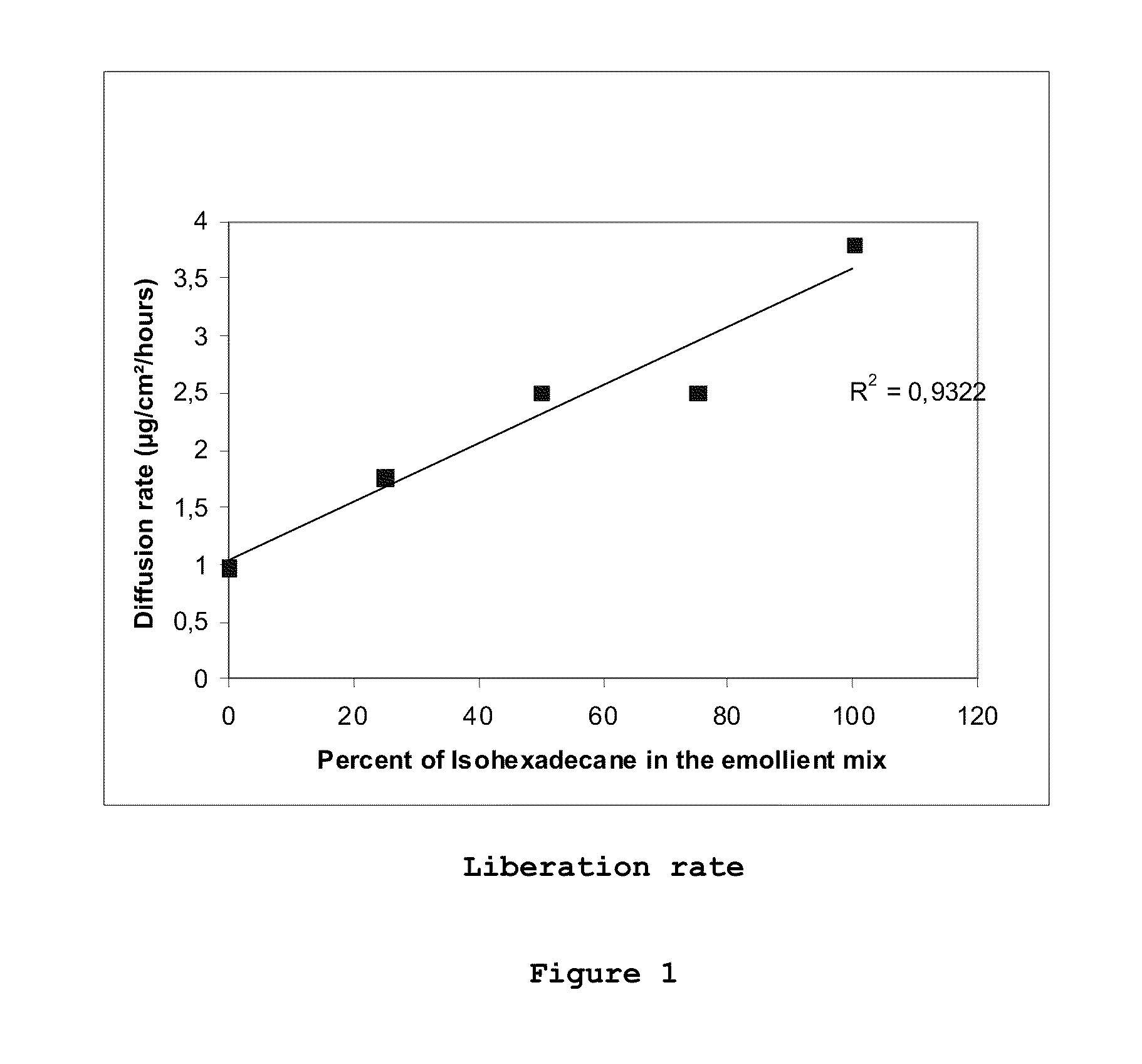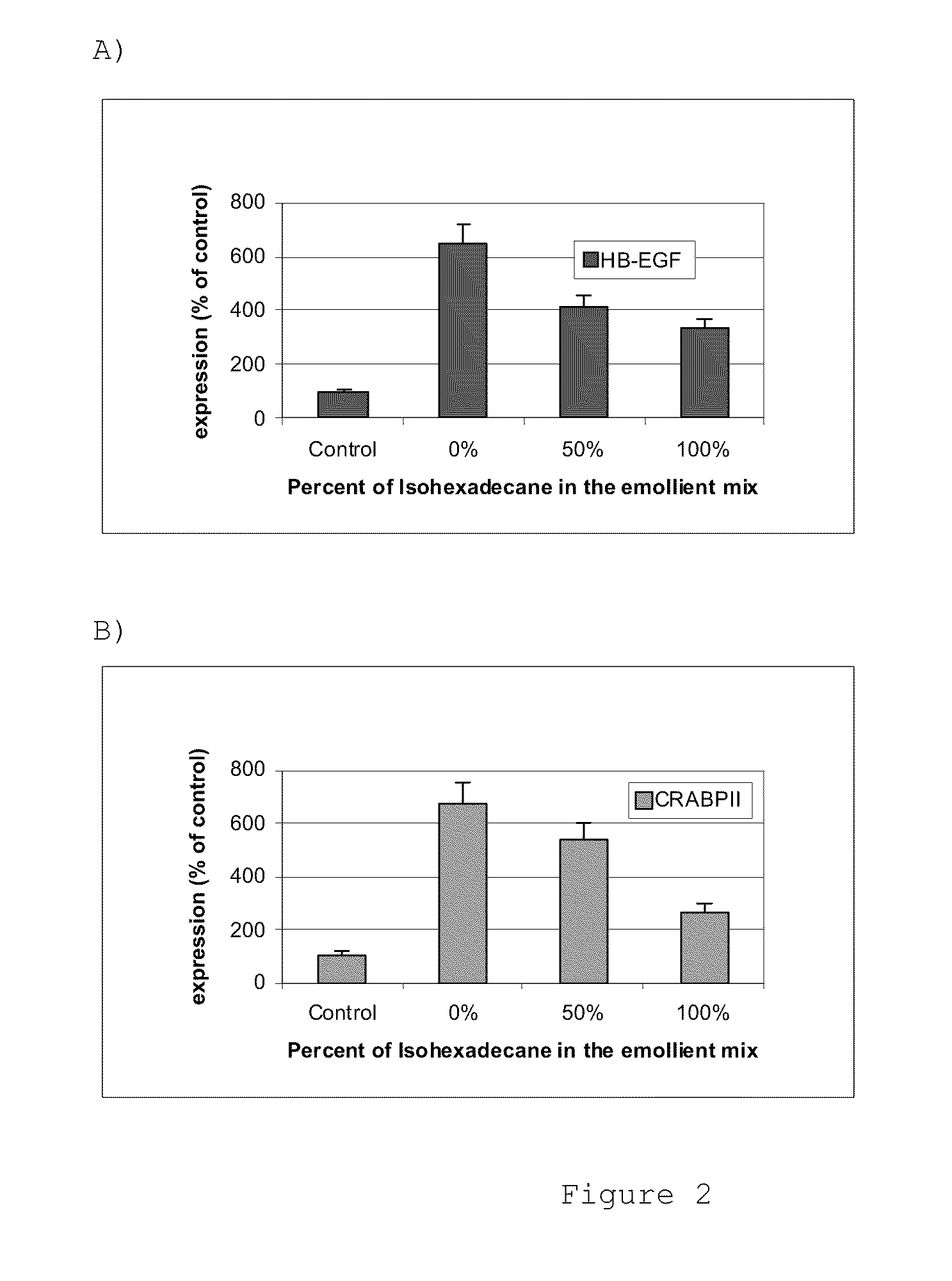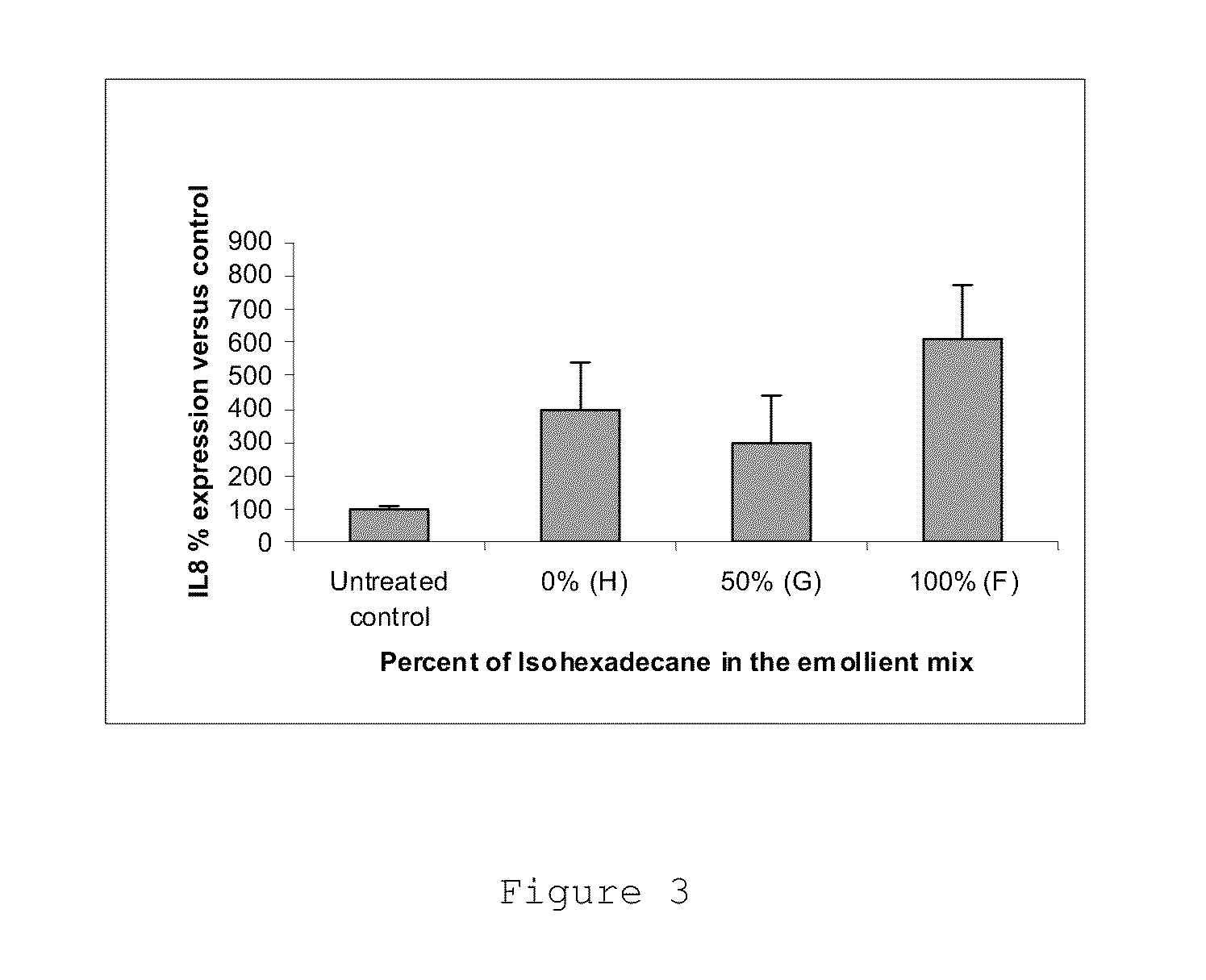composition and method of treating skin conditions
a technology applied in the field of composition and treatment method of skin conditions, can solve the problems of pigment defects, fine lines and wrinkles, irritating retinoids, etc., and achieve the effect of reducing the appearance of fine lines, wrinkles, stretch marks, or celluli
- Summary
- Abstract
- Description
- Claims
- Application Information
AI Technical Summary
Benefits of technology
Problems solved by technology
Method used
Image
Examples
example 1
Cosmetic Compositions
[0060]Tables 1 and 2 show examples of compositions according to the invention.
TABLE 1EmollientEmollientEmollientEmollient7%7%20%20%Ingredient(w / w %)(w / w %)w / w %w / w %AquaQSPQSPQSPQSPCarbomer0.40.40.40.4Disodium EDTA0.10.10.10.1Methyl Paraben0.20.20.20.2Propyl Paraben0.150.150.150.15Phenoxyethanol0.50.50.50.5Sodium Hydroxyde1111Glyceryl2222Stearate; PEG-100StearateBHT0.10.10.10.1Cetyl Alcohol1111Isohexadecane3.50.5100.5PPG-15 Stearyl3.571020EtherRetinol0.1150.1150.1150.115Polysorbate 200.1350.1350.1350.135Ascorbic Acid0.050.050.050.05
TABLE 2Ingredient% w / wAquaQSPAmmonium Acryloyldimethyltaurate / VP Copolymer0.50Disodium EDTA0.10Allantoin0.10Glycerin5.0Butylene Glycol2.0Caprylyl Glycol0.50Methylparaben0.250PEG-85.0Dihydroxymethylchromone0.10Cetearyl Alcohol; Ceteareth-203.0Stearyl Alcohol; Ceteareth-203.0Ethylhexyl Methoxycinnamate2.0Isohexadecane1.5PPG-15 Stearyl Ether4.5Pentaerythrityl Tetraoctanoate7.0Butyrospermum Parkii (Shea Butter)1.0Tocopheryl Acetate0.25BHT...
example 2
Effect of Emollients on the Rate of Retinol Liberation
[0062]Compositions that liberated retinol at different rates in vitro were prepared by varying the weight ratio of the polar and non-polar emollients contained therein. This was done by solubilizing retinol in a mixture of two emollients of different polarities: PPG15 stearyl ether having a net relative polarity index to retinol of (i.e., having the same polarity as retinol) and isohexadecane, having a net relative polarity index to retinol of 9.11. The total concentration of emollients in each composition was 7%; however the ratios of the two emollients were different. The compositions (Formulations A-E) are shown in Table 4.
TABLE 4Formulation (w / w %, ROL 0.1%)IngredientABCDEAquaQSPQSPQSPQSPQSPCarbomer0.40.40.40.40.4Disodium EDTA0.10.10.10.10.1Methyl Paraben0.20.20.20.20.2Propyl Paraben0.150.150.150.150.15Phenoxyethanol0.50.50.50.50.5Sodium Hydroxyde11111Glyceryl Stearate;22222PEG-100 StearateBHT0.10.10.10.10.1Cetyl Alcohol11111...
example 3
Effect of Retinol Liberation Rate on Retinol Activity
[0064]The additional formulations, Formulations F-H, were prepared. The amount of retinol in each formulation was adjusted such that the formulations delivered the same amount of retinol after 24 hours of application but at different rates. The compositions of Formulations F-H are shown in Table 6.
TABLE 6EmollientPPG15ratioStearylIsohexade(nonRetinolethercanepolar / (wt %)(wt %)(wt %)polar)Formula F0.115% 0% 7%7 / 0Formula G0.226%3.5%3.5%1 / 1Formula H0.306% 7% 0%0 / 7
[0065]Retinol activity was measured by assessing the expression of two gene markers relevant for retinoid activity in the epidermis, the Heparin Binding Epidermal Growth Factor (HB-EGF) and the Cellular Retinoic Acid Binding Protein 2 (CRABP2). The retinol irritation effect was measured by assessing the expression of a marker for skin subchronic irritation, interleukin 8 (IL8). Formulations F-H were applied to human skin explants for 24 hours and gene expression was meas...
PUM
| Property | Measurement | Unit |
|---|---|---|
| weight ratio | aaaaa | aaaaa |
| weight ratio | aaaaa | aaaaa |
| weight ratio | aaaaa | aaaaa |
Abstract
Description
Claims
Application Information
 Login to View More
Login to View More - R&D
- Intellectual Property
- Life Sciences
- Materials
- Tech Scout
- Unparalleled Data Quality
- Higher Quality Content
- 60% Fewer Hallucinations
Browse by: Latest US Patents, China's latest patents, Technical Efficacy Thesaurus, Application Domain, Technology Topic, Popular Technical Reports.
© 2025 PatSnap. All rights reserved.Legal|Privacy policy|Modern Slavery Act Transparency Statement|Sitemap|About US| Contact US: help@patsnap.com



